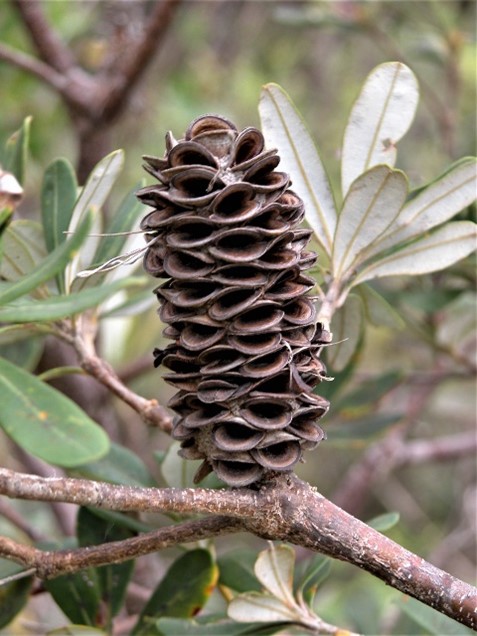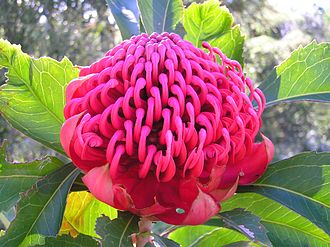These four, typically Australian genera all belong in the same plant family Proteaceae, a family of flowering plants primarily distributed in countries south of the equator. A most plausible explanation for this distribution of Proteaceae in South Africa, South America, Australia was rendered to biogeographers when in the 1970s geologists were able to demonstrate that these three continental areas were originally contiguous and part of the ancient supercontinent Gondwana. Following plate tectonics and continental drift sections of the genus Proteaceae that has been confirmed by fossil evidence to have originated in Gondwana, became separated by oceans and evolved locally from this original source. In Australia and nearby Islands, over forty genera arose in the Proteaceae family but only a few features of four of these are considered in here.
The ‘Protea’ part of this name was first used by Carl Linnaeus (senior) to describe a species from South Africa and the name itself is derived from Proteus the sea-god capable of changing its shape at will. This characteristic of the family is well exemplified in the Genus Grevillea especially when applied to the leaf shape of species that may vary from stiff narrow and pointed to compound divided types, and from holly-like to oval shaped leaves with entire margins.
In Australia soils there are generally low nutrient levels and in particular there is a deficiency of phosphorus as a mineral essential for plant growth. Further in many parts of the continent long seasonal dry periods and drought are common. It is not surprising that most genera of Proteaceae have responded to these conditions with the development of a ‘supplementary’ root system and produce clumps of fine rootlets that would add considerably to the plant’s underground root surface area and hence capacity to uptake nutrients and water. These clumps are referred to a proteoid roots, they are often formed close to the soils surface and have a limited life. They may be easily observed by exposing the near-surface root zone of coast banksia, B. integrifolia a species found associated with coastal sand dunes along much of south eastern Australia.
The Grevilleas and Banksias have most of their species represented by plants that are endemic to southwest, Western Australia (WA). Of all the Grevillea species more than half grow on the sandy and lateritic soils in WA, with two of their 273 species in Papua New Guinea, one in the Celebes, three in Caledonia and the rest throughout Australia and Tasmania. Species vary in their habit of growth from prostrate shrubs to small and tall shrubs. Only one species, silky oak (G. robusta) is found as a rainforest tree and when plenatiful in days past was favoured by furniture and cabinet makers, and for cooperage (barrel making). Grevillea is closely related to Hakea and in fact some taxonomists combine them under Grevellea. However, for those who treat them separately will remember that most Grevillea have a thin walled follicle enclosing the seed but in most Hakea species the follicle wall is thick and woody.


Banksia
Banksia is a much smaller genus than Grevillea with some 58 species in WA and the other 17 species naturally distributed around the perimeter of continent and in Tasmania. Of interest in their distribution is that of B. dentata – a tropical species and the only one growing on the coastal Kimberley of WA, Top End of the Northern Territory and the tip of Cape York peninsula in Queensland. This genus was first described by Carl Linnaeus, the son of the great taxonomist, and named after Sir Joseph Banks who with Daniel Solander collected the first specimens when they sailed with Captain James Cook in 1770 to east of what became known as Australia.
The attractive diversity in the floral structures has led to the popularity of Banksia species being favoured by gardeners and landscapers but like many Australian native species are naturally adapted to phosphorus deficient soils a point that need to be remembered by home gardeners when applying fertilizers.
After flowering some of the many flowers in the spike may develop seeds inside a woody follicle. In May Gibbs’ book for children the Gum Nut children Snugglepot and Cuddlepie referred to the Banksias woody fruiting ‘cones’ as the villainous ‘big bad’ Banksia men. The pictured spike has had most of its flowers develop follicles and is not as fearful looking as spikes with poor development and just a few opened follicles in the imaginary pattern of eyes and a mouth set in a mass of hairs formed from the stamens of the spent flower.

Waratah
Waratahs belong in the Telopea genus and produces an attractive red flower. There are three species limited to eastern NSW, Victoria and Tasmania and T. speciosissima (Sydney waratah) has been adopted as the NSW state floral emblem. Several waratah cultivars have been adopted as garden plants in Australia and overseas, and T. speciosissima was introduced to England in 1789.
Some waratah species favour moist habitats and the Gippsland waratah, T.oreades and the Tasmanian waratah (T. truncate) favours wet sclerophyll forests with the former species also found in temperate rainforest environments. Alternatively, Sydney waratah is found in dry sclerophyll forest west of Sydney and the Illawarra and in northern NSW on the well-drained granite soils of the Gibraltar Range.

Several species are pyrogenic meaning their grown is related to fires. Sydney waratah flowers soon after its habitat has been burnt and seed resulting from flowering germinate quickly, suggesting that this species has seedlings taking advantage of the reduced competition in the post-burn growing conditions.
Many Banksia species hold their seed in their woody follicle until stimulated by fire. Like many of the Eucalypts, both Banksia and Telopea species may produce epicormic shoots on their trunks or underground lignotubers to regenerate following fire. In Banksia, particularly species adapted to fire-prone areas, this is a fairly rapid response but with Telopea there may be a two year delay before regrowth occurs.
Macadamia
There has be extremely limited commercialisation of Australian plant species for food and although they function for example as grazing and garden plants, in the cut flower industry, as a timber source, for oil production or for tanning bark, none can match the growth of the macadamia nut industry.
Cultivation of macadamia for nut production began with seed taken from Australia to Hawaii in 1882 with orchard production beginning in the 1920s and true commercialisation in 1948. By 1999-2000 macadamia was produced on 650 Hawaiian farms with eight of the largest farms spread over 15,000 acres (over 6070 hectares).
Australia, the home of the two species Macadamia integrifolia and M. tetraphylla grown in Hawaii, was not to enter into commercialised production until the 1970s even though the local farmers were made aware of the nut’s potential in 1930. By the 1970s production was limited to M. integrifolia and its cultivars and hybrid varieties resulting from M.integrifolia crossed with M. tetraphylla. These were grown from in east coast orchards of Australia extending from the NSW north coast to the Atherton Tablelands inland from Cairns (QLD). In 2009 over 65% of production of nuts was in NSW and over 34% in Queensland with a total of over 33,000 tonnes of nuts (in shell) from nearly 15,000 hectares of trees.

Macadamia has 11 species with seven from the mainland Australia, three from New Caledonia and one from the Celebes. In their natural conditions Macadamia grow as tall shrubs or trees in rainforests. The fruits (nuts) are globular with a hard outer covering. Flowers of macadamia are regularly self pollinated but studies have shown that under cultivation yield may be increased following the introduction of bee hives to orchards. Large areas of cultivated plants requires the cooperation of apiarists with the macadamia orchardists to ensure successful pollination and the desired result of more flowers producing nuts.

